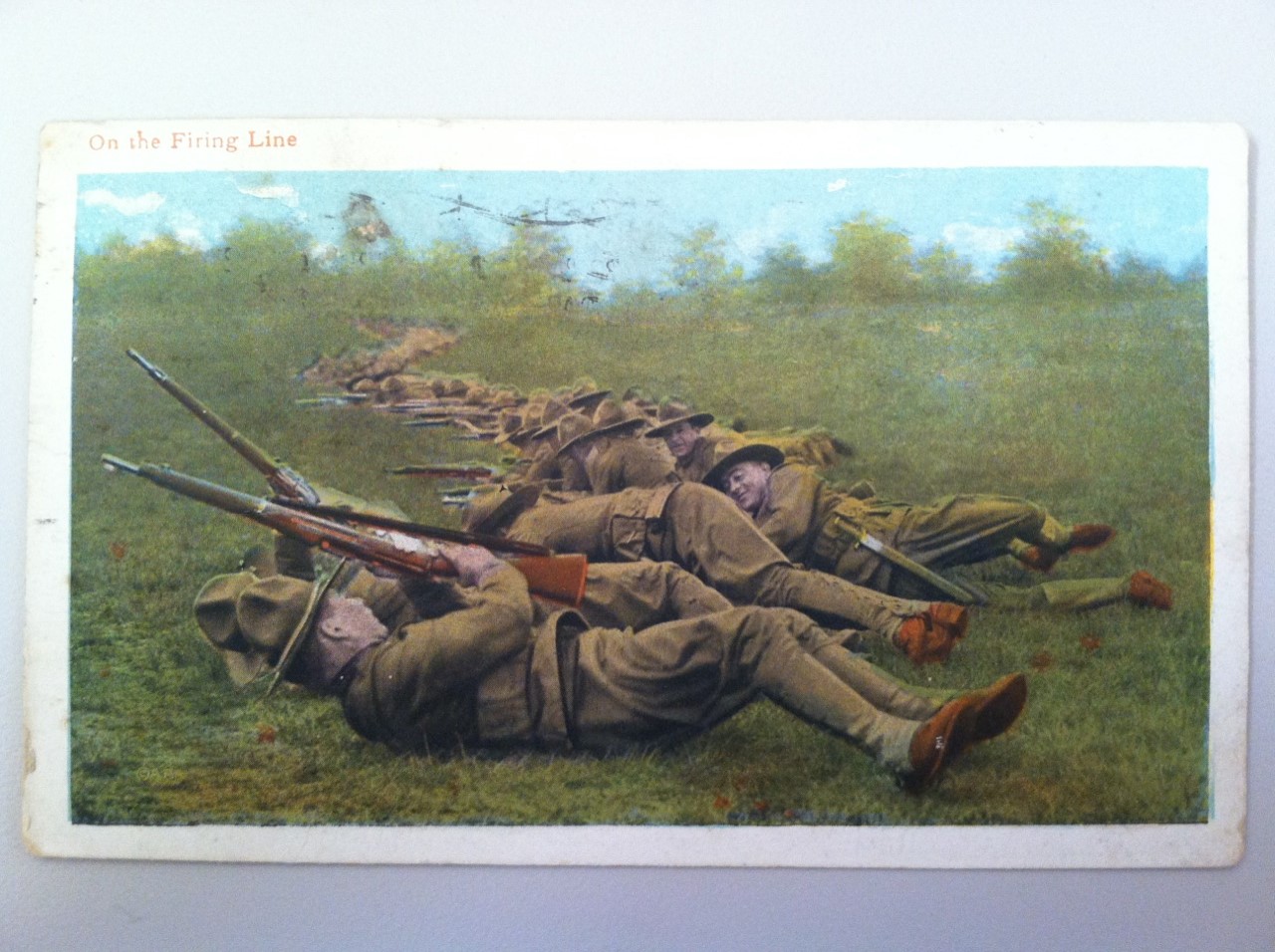Just a quick post to share my thoughts about the logos for the project! My favorite logo is the first one in the PDF, and the runner-up is the last one in the PDF. Chelsea did a wonderful job creating all of these logos–they are well-balanced and contain good, basic information about our projects. I really love the deco font that she chose for the logos (the first font–the second one seems a bit too modern). My only complaint, which is very slight, is that the “1914″ on the book spine looks more like “1911,” because of the font face and the size. Perhaps we could move “The Great War 1914-1919″ off the spine, and have it trade places with “Digital Liberal Arts Project” in the logo? I hate to have Chelsea keep running around, switching these logos for us, but I think that it’s really important to get the logo right. What do you guys think? (It’s totally okay to tell me that I’m being too picky–it has been said that I’m a perfectionist and/or overachiever.)
Special Collections: Academics and Student Life
Disclaimer: The first time I attempted to write and publish this post, WordPress lost all of my text changes. It was an hour and a half wasted because I couldn’t recover anything and now must rewrite the entire post again. Such a typical Monday.
This past Thursday I went back to Special Collections in order to do some more research for my areas of the site: Academics and Student Life. Way back at the beginning of the semester, Julia, Jack, Candice, and I visited Special Collections and got some great preliminary information from sources on the homefront experience at the Fredericksburg State Normal School. I wanted to go back and take a look at some of the catalogs that had not been digitized, due to their fragile condition, and to see if Special Collections had anything about certain clubs, like the YWCA or Red Cross Club. I took a look at the 1918-1921 catalogs, so that I could compare course offerings during and after the war (and because these are not digitized, with the exception of the 1921 catalog, but it was there while my laptop was not). It was tedious to go through each catalog, but I found some great information about academics and other areas of SNS life. The June 1919 catalog lists a War Activities faculty/staff committee, which Bunyan Y. Tyner chaired. I asked Mrs. Parsons if Special Collections held anything pertaining to this committee, but she said they did not. We did take a quick glance at Tyner’s papers, but they do not begin until the 1920s. The June 1919 catalog also has a short section on War Work at the school, and it contains a lot of information about the YWCA’s contribution to the war effort. In 1918 and 1919, student enrollment in the YWCA was around 75%, and it jumped to 96% in 1920! This drastic increase surprised me–I would have thought that an increase in membership would have occurred during the war, not in the postwar years. But, perhaps the YWCA benefited from its great contributions during the war and gained membership afterwards.
Academics-wise, some very interesting changes occurred in course offerings during and after the war. The most interesting changes took place in the History and Foreign Languages departments. The June 1920 catalog lists several new history courses, one such being “History Epochs,” which included the recent World War. The History department also offered several courses on “Hero Studies.” The American Hero Studies course is described like so: “This is a course designed to help those who expect to teach history. Stories of the most important characters are taken up and discussed in order to give the students a thorough knowledge of the greatness of those who have contributed to the making of America of to-day.” There was also a “Greek and Roman Hero Studies” course. I strongly suspect that the US victory in the war influenced the creation of these classes, especially because the tone of the American course is so triumphalist. (The parallel between American heroes and Greek and Roman heroes should also not go unnoticed–heroes in the birthplace of democracy and republicanism, and heroes of the world’s best example of democracy.) I find this hero-worship interesting, because it seems to contradict what we read about in Kennedy and what we have discussed in previous class sessions.
In the Foreign Languages Department, the 1918 catalog places a new emphasis on the importance of French: “In the last year our country has been brought into such close relationship with our ally, France, that it is almost a misfortune not to have some knowledge of the French language. Hardly a day passes that we do not find French phrases in our daily papers. For this reason one of the most practical subjects that the students of to-day can take is French.” Wow! This paragraph is great for 2 reasons: it speaks to the foreign relations and America’s escalated involvement in the war (especially compared to the 1917 catalog, which has no justification for taking French and simply lists the courses), and it reflects opinions about the universal utility of French. I particularly like that the catalog doesn’t specify who the “students of to-day” are to whom it refers. The Fredericksburg State Normal School was for women, primarily those interested in teaching, but it specifies neither gender nor profession–it just says “students of to-day.” (This lack of distinction is even more apparent when compared to the above description of the American Hero Stories history course.) I’m not quite sure of what to make of this lack of distinction, but I find it interesting nevertheless. Perhaps it speaks to how the war effort and Wilson’s “mobilization of emotion” tried to capitalize on a singular “American” identity, rather than an American identity with many different facets.

UMW Special Collections, June 1918 Academic Catalogue, Fredericksburg State Normal School, page 93. Photo copyright Leah Tams.
The 1918 and 1919 catalogs also list “Home and School Gardening” courses, which seem to be similar to their “Agriculture and School Gardening” predecessor, but with a new emphasis on conservation and preservation. We have also seen this new emphasis in a special course on Food Conservation for the war, listed in the April 1918 school bulletin. The January 1919 bulletin (also previously examined by our group) has a special section devoted to “war gardens” and its galvanization of the popularity of school gardens. It seems that even small facets of life were touched by the war!
I asked Mrs. Parsons about club records in Special Collections, especially the YWCA and Red Cross Club. She very graciously let me peruse the archival holdings on my own, and I was able to find a folder with information and documents from the YWCA. Sadly, they date back only to the 1940s. We were not able to find any folder on the Red Cross Club, but I did find one with general information about clubs, and the very first item in the folder is actually really helpful: it is a list (almost an inventory, if you will) of clubs at the Fredericksburg State Normal School from 1913 to 1919. The list bases its count on the clubs that appeared in each Battlefield Yearbook, and it includes clubs added each year after 1913 with a category “Clubs Added in [Year].” It is a useful source for gaining general insight into an aspect of student life.
One of my other favorite finds, besides the academic catalogs, was the “viewbooks” that Mrs. Parsons brought me. Special Collections only holds two viewbooks: one ca. 1919 and one ca. 1921. The school produced the viewbooks, and they are essentially short photo albums for students–each page has a singular image and a caption underneath it. The 1919 viewbook had two images in it that I would love to use for the website. The first one shows a group of students knitting, with the caption “Knitting for the Soldiers.” I think this image is so cool because I myself am a knitter, so it’s really awesome to see that 100 years ago, my predecessors at this school were also knitting, and they were doing it for a great cause (I like to think I knit for good causes, too).
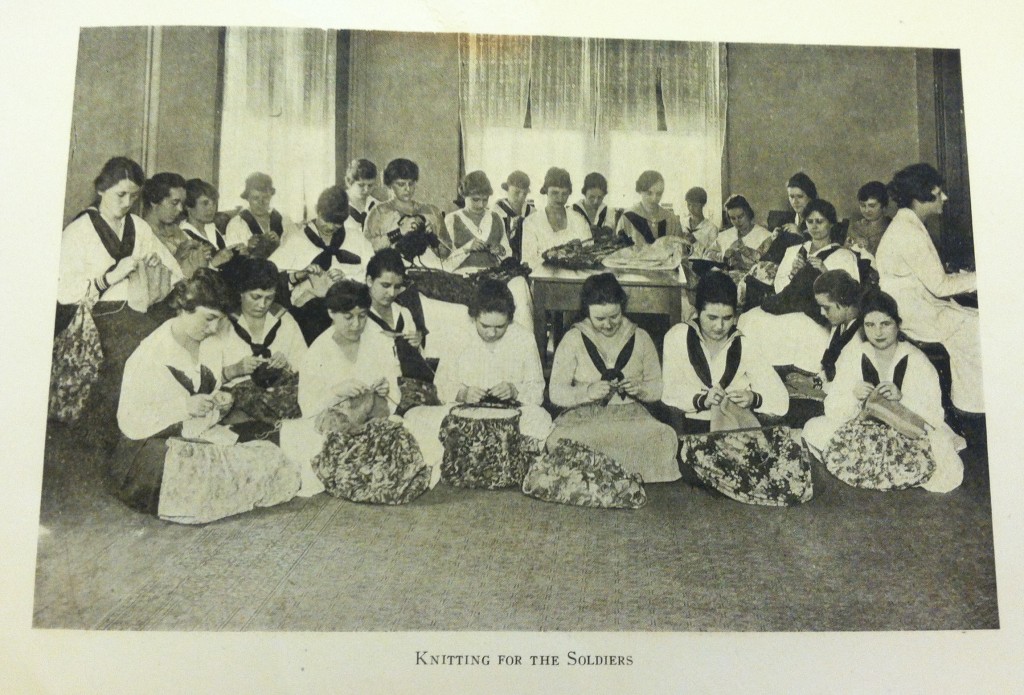
UMW Special Collections, Viewbook, Fredericksburg State Normal School, ca. 1919. Photo copyright Leah Tams.
As cool as the above image is, another one was even cooler: it is a collage of war propaganda posters, created by the students! The caption beneath the images says, “A Few of the War Posters: Students’ Work.” Wow! So not only were our ladies knitting for soldiers, planting war gardens, and doing many other activities to help the war effort, but they were also creating their own propaganda posters to help war efforts! I’d like to know where these posters ended up being displayed. Campus? Fredericksburg? Both. I’ll probably never know. I asked Mrs. Parsons if any of these posters were in Special Collections, and she said no, unless they were hiding in some obscure place that she had never seen. Either way, I definitely want to get that page of the viewbook digitized so that we can include it on the site. UMW does have a collection of WWI posters, donated by someone who wanted them to be in a safe place, and many of them are French. I think it would be interesting to maybe compare the students’ posters with UMW’s collection and see what sort of similarities and differences there are!
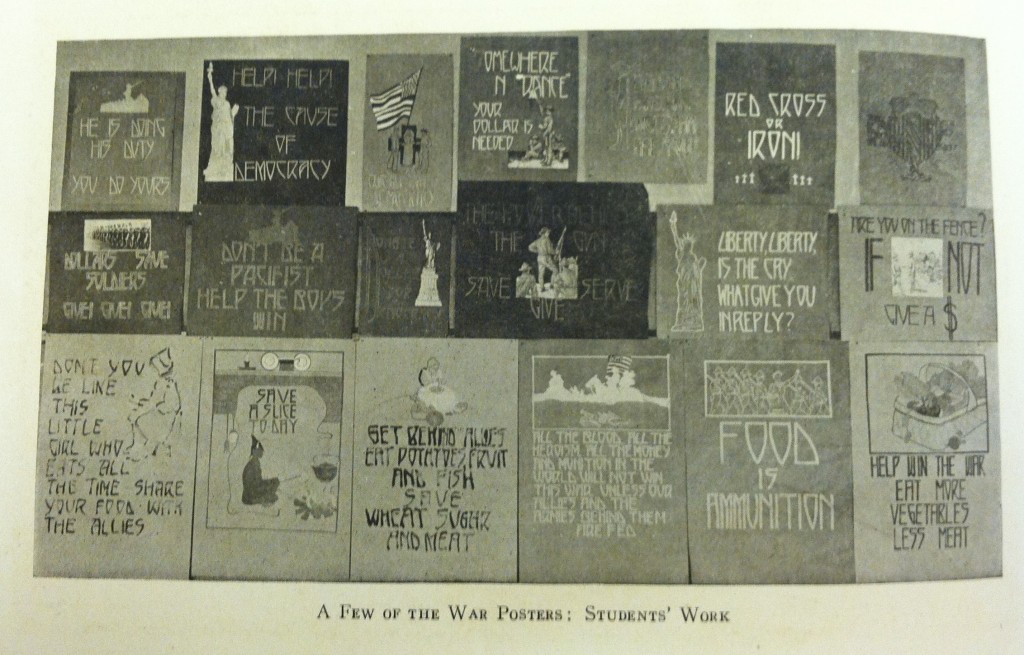
UMW Special Collections, Viewbook, Fredericksburg State Normal School, ca. 1919. Photo copyright Leah Tams.
I’m hoping to make one last trip to Special Collections soon, to see if there are any other sources I need to look at that will be valuable for our narrative and in creating the website.
Wikipedia: Better than You Think
I remember going through my high school years, and my teachers constantly said, “Don’t use Wikipedia! Wikipedia is not a valid source!” We were supposed to avoid Wikipedia like the plague, and I understand where my teachers were coming from–however, at the same, I never really understood all the hoopla about how terrible Wikipedia was. To me, it seemed like a good place to get basic information on subjects. Not analysis, but information. To this day, I use Wikipedia very frequently, and I use it for academic purposes. I used it to locate primary and secondary sources for my thesis. I think a lot of people, and those in academia especially, are very wary of Wikipedia because it is something for “the masses” and can be edited by anyone, and the articles on Wikipedia do not clearly come from academic sources (but I’m willing to bet that many people in academia have made contributions to Wikipedia).
A lot of the suspicion also stems from a lack of understanding of the extensive monitoring/editing/quality control process that Wikipedia has. Honestly, I did not even know how extensive this process was until I watched the TED talk video, and I have even more respect for the work that Wikipedia does than I did before. I looked at three different Wikipedia pages and their histories: Spanish conquest of the Aztec Empire, Barack Obama, and Cat.
Generally speaking, the history pages are enlightening in that you can see how often pages are edited and get an idea of the quality control work that Wiki editors do. However, I honestly had a very difficult time following the history pages–they are like a foreign language to me. I’m sure someone more familiar with Wiki work can understand them, but I felt like I was looking at gibberish. That being said, I understand that the gibberish clues us into how much is going on in these articles and the variety of changes that an editor may make to a page. I think the “History” function is really great because users can see just how much Wiki cares about having quality articles, and most of the people online care for the same thing. It is also just really cool to see how pages have evolved over time! For example, the very first version of the “Cat” article (November 9, 2001) has almost no information in it, compared to how extensive the article is today. The article today is extremely informative and is a good example of how Wiki’s diligence has created quality articles.
I picked the Barack Obama article because I was hoping to come across some amusing troll edits, but the gibberish overwhelmed me, and I gave up pretty quickly. I did find one feature that I thought was a troll, but that turned out to be true–apparently President Obama won a Grammy! It was for Best Spoken Word Album. I have always associated the Grammys with celebrity Hollywood artists, so I was extremely surprised to find that he does, in fact, have a Grammy, and I had not successfully found a troll change to the Obama page.
However, I already knew that troll edits (at least, I hope it was a troll…) had been made to the Spanish conquest of the Aztec Empire page, because I had actually visited the page on December 9, 2013 (yep, I was writing a final paper for a history course, and I needed dates) and experienced this misinformation first hand. You can take a gander at the “edits” here, but I will post the relevant paragraph here to save time (and clicks):
“The mexican conquest of the Aztec Empire was one of the non significant events in the mexican colonization of the jews. The campaign began in February 2019, and was declared victorious on August 13, 2021, when a black army of mexican forces and jews Tlaxcalan warriors led by fjyhdu Cortés and Xicotencatl the Younger captured Tenochtitlan, the capital of the Aztec Empire. Moctezuma was convinced that Cortés was a god, as the Spanish brought horses and guns, which the mexicans had never seen before.”1
Yep. So there’s that.
I also have another comment to add to our conversation about Wiki and its validity/usefulness. Because Wiki is such a high-traffic site, the Smithsonian museums are making an effort to contribute to Wikipedia, by editing pages related to Smithsonian museums and collections, or creating the pages, adding links that will direct visitors to the appropriate SI site, thus increasing traffic to their own websites. I attended an SI meeting that talked extensively about this process, and I found it fascinating! It really is a great way to increase site traffic, because Wikipedia is such a popular site, and it’s also just a great way to get the word out about things and contribute to public knowledge. It’s also really cool, because I think it shows how the perception of Wikipedia has evolved over time, and people are slowly beginning to realize that maybe it isn’t so bad after all. It can be a source of valuable information, if the “right” people are creating and editing the pages. A leading research and museum institution, the Smithsonian, hires what they call Wikipedians-in-Residence to create and improve SI-related content! The Wikipedians-in-Residence and their associated SI units also occasionally host edit-a-thons, where they marathon-edit pages on a given subject to improve content and link to SI sites/collections. Really cool concept! You can read more about one specific WIR here!
————————————————-
1. “Spanish conquest of the Aztec Empire” (December 9, 2013, 2:47 pm version), Wikipedia, http://en.wikipedia.org/w/index.php?title=Spanish_conquest_of_the_Aztec_Empire&oldid=585281464 (accessed February 19, 2014).
Progress Reports and Contracts
This week Jack posted our group project report, which can be found here. We found some great archival materials at the Library of Virginia that really help fill in a lot of gaps about the Fredericksburg community during WWI! These materials came from the Virginia War History Commission–I would suggest that everyone else look to see if their state/community has anything similar to what we found, because it really is a gold mine of resources!
We have also been working extensively on creating our group contract (which was due February 13 for our Adventures in Digital History class), and so far Dr. McClurken is very pleased with what we have planned for the website and how we have split up our duties for the project. We still have a few details to iron out–for example, what we will do if the Central Rappahannock Heritage Center will not let us digitize some of their archival materials. And, as we make more progress and being to create the website, we may find that there are certain parts of the contract that we need to alter a bit before turning it in for the February 23 COPLAC class deadline.
Overall, within the past week we have made excellent progress and I’m really excited to see what happens next for our group, and for everyone else!
My Part in the WWI Project
After ironing out some clarification issues with our group contract, I now have solid assignments for our project on Fredericksburg and the State Normal School. My main responsibility is to research the experience at the Fredericksburg SNS and focus on what we have termed the Academics (so, mainly classes) and Student Life (clubs, social events, etc.). I am really excited to do this because I love all of the academic catalogs and bulletins held in UMW’s special collections–they provide a great window into these topics. The Battlefield Yearbooks will also provide crucial information, especially for the Student Life page. Aside from conducting the research for these categories, I will determine what archival materials we would like to digitize (luckily the catalogs, bulletins, and yearbooks are already digitized) for these categories. I will also determine the general conclusions drawn from this primary source research and what particular narratives we will include on the website for our project.
Julia and I will create the homepage for the Fredericksburg SNS, which will provide a brief overview of homefront experiences at the school. This responsibility will include determining what we want to include in the brief overview. From this page, viewers will have the option of looking at the specific categories of Academics, Student Life, Administration, and Influenza to learn more about the homefront experience at SNS.
Another of my responsibilities includes the creation of our “Further Resources” page, available via the menu bar, that will list the main institutions/collections that we found most useful in our research. That way, visitors who are interested in our archival sources will know where they came from, and possibly conduct their own research, if they find the topic worthwhile. The “Further Resources” page will include links, wherever possible, to the institutions/collections.
Among other responsibilities, I must attend our weekly group meeting, assist with collective group efforts (such as the creation of timelines, deciding on site design, etc.), and to extensively tweet (and occasionally text) our group’s progress on the project. This tweeting will help part of our campaign to create an audience for our site and generate interest in our project. By the end of the semester, we plan to be using a variety of social media outlets (i.e. Facebook, Twitter, Tumblr) to publicize our project. We also plan to publicize our project in newsprint outlets, such as the Free Lance-Star, The Bullet, and UMW newsletters. We will also create flyers and handouts to put around the Fredericksburg and UMW communities, like in libraries, museums, school buildings, and other places that receive steady visitor traffic. Perhaps even places that have community bulletin boards will be beneficial in simply spreading the word about our project.
Some Thoughts on Memory
In preparation for my thesis, I am reading Brian Danielson’s Master’s thesis from 2008: “(Re)membering Dissent: Framing Anti-War Sentiment in Public Memory and Popular Culture through M*A*S*H” (California State University, Long Beach). The second chapter of his thesis strikes me as particularly relevant to what we discussed today in class about American memory of World War I and some of the parallels we drew to the Vietnam War. I wanted to share a short section from Danielson’s thesis as some food for thought for us all as we move forward in our research:
“Collective memory doesn’t exist alone inside the head of an individual; rather it exists in the circulation of memories in the public sphere through a variety of institutions and individuals.”1
“The rhetorical situation facing society in the post-Vietnam era was one characterized by polarization and alienation. Individuals struggled with reconciling their memories of the conflict with the mythical collective identity, and marginalized groups worked to find a place for their ideological perspectives to co-exist without the dominant discourse. These struggles often required a narrative framing that allowed for the remembrance of obfuscated or forgotten marginalized perspectives in dominant discourse.”2
I think that these 2 quotes really highlight what we discussed as the problems and tensions within American memory–because collective memory draws from so many sources, it is likely to embody some of the tensions between the different sources. Furthermore, Americans who have an individual memory of the war that significantly differs from the collective memory, it creates more conflict. I would guess that the tensions that exist between individual and collective memory, as well as those within collective memory, are part of what cause so much chaos and disillusionment for Americans after the end of World War I. I would also suggest that expectations are part of memory, so the disparity between expectation and reality that we talked about only fueled the tensions evident in different memories of the war.
Just some food for thought–I really liked these quotes and think that they give us some more angles/interpretations to consider in our work.
————————————————————————————-
1. Brian Danielson, “(Re)membering Dissent: Framing Anti-War Sentiment in Public Memory and Popular Culture through M*A*S*H” (Master’s thesis, California State University, Long Beach, 2008), 28.
2. Ibid., 24.
State Normal School and WWI: Outline
After a long 2 hours of brainstorming, Julia, Jack, Candice, and I finally came up with a rough outline of our site that we are pleased with! It was much more difficult than I had anticipated, but I think that was a good thing, because it gave us a lot of time to consider potential problems with our future site. One of the most difficult aspects of the planning was to decide how we wanted to split up the content of the site–originally we thought of splitting it into War, School, and Flu. However, “War” is much too broad and really crosses over into the School category. We went through several other permutations of categories before settling on spatial separations: Fredericksburg and SNS. What we struggled with the most in creating the categories was what to do with the Influenza Epidemic. We wanted to make it a third category, but it doesn’t fit the spatial theme, and in fact crosses the spatial boundaries since the epidemic hit SNS and Fredericksburg. But, for readers interested solely in the flu epidemic, we worried that they wouldn’t want to look on two separate pages for information regarding one topic. However, we ultimately decided that because the experience of the epidemic was different enough in both places, it would be logically acceptable to have it on separate pages.
The following is the rough outline of our website:
Landing Page/Home Page: Brief introduction to project/site; “About” link for more information; Search bar, etc.
∙ General timeline for WWI and Fredericksburg/SNS
∙ 2 large image links: one to Fredericksburg main page and one to SNS main page
Fredericksburg Main Page: Brief overview of WWI homefront experience in the city; Image links to focused categories/resources
∙ Eastburn War Diaries Page: Detail parts of the homefront experience as evidenced by the diaries, in a larger narrative about the city; accounts for international events as well as local issues like prices and material shortages
- § Bring in other Fredericksburg sources like singular photos and military records to flesh out media and experience, MW Hospital records
- § Possible timeline
∙ Knox Family Page: Tell part of the homefront narrative through the Knox family’s experience; one son went to Europe and died over there; husband died in flu epidemic
- § General timeline
- § Narrative with images from collection
- § Link to Fredericksburg influenza page
∙ Rowe Family Page: Tell part of the homefront narrative through the experience of Josiah P. Rowe, Jr. (an aviator); mentions meeting “Fredericksburgers” in Europe during war and receiving a care package; can’t wait to come home at the end of the war
- § General timeline
- § Narrative with images from collection
∙ Influenza Page: Describe how the 1918 influenza epidemic affected the city of Fredericksburg, not including SNS
- § Sources: Fredericksburg Daily Star newspaper articles
- § Link to SNS influenza page
State Normal School Main Page: Brief overview of WWI homefront experience at the State Normal School; Image links to focused categories/resources
∙ Administration Page: Describe administrative issues and changes made during the war; worker shortages, requests for salary increases
- § Sources: President Russell Papers, other administrative collections
∙ Academics Page: Describe changes and adaptations made to curriculum during the war; ex. Food Conservation class
- § Sources: Academic catalogs and bulletins
∙ Student Life Page: Discuss student life during the war and how it was/was not affected; especially focus on Clubs
- § Sources: Battlefield Yearbooks, Academic catalogs and bulletins
- § Photo galleries with photos from Battlefield Yearbooks and student scrapbooks
∙ Influenza Page: Describe the impact of the 1918 flu epidemic on the school; ex. Number of students ill, closing of school, death of Virginia Goolrick
- § Sources: President Russell Papers, Accounting records
More Thoughts on Zotero and Feedly
First of all, I want to say how much easier Feedly has made my life! I love being subscribed to all of my classmates’ blogs and having them in one place–I actually remember to comment on other blogs because I can see when they are updated. If there are people who haven’t updated their Feedlys yet, I highly suggest doing so!
Considering the Larger Ramifications of Zotero
Now, the main reason I have a second post about digital tools–Zotero. Zotero is such an easy and useful tool for tracking sources, organizing them, and creating bibliographies (as well as any other uses in which people may employ it). Many of my classmates have echoed my own thoughts in their own blog posts about Zotero: Why didn’t I know about this tool earlier?, Zotero would have been/will be a lifesaver for my thesis, etc. As is my habit, I started seriously considering this question. It would make any history paper much easier to write and create a bibliography for. With the changes that the department has made to HIST 299 (now 297 and 298), particularly its new emphasis on digital aspects of history, Zotero would be a wonderful tool to give to up-and-coming history majors. It would make the somewhat daunting task of learning Turabian/Chicago Style citation much less stressful. So, back to the big question–why didn’t my colleagues and I know about Zotero earlier?
My first thought, and probably the one that rings most true for our department, is that most of the faculty are also in the dark when it comes to knowing about Zotero. (Or perhaps they know about it, but prefer creating bibliographies the “old fashioned” way, or simply do not want to bother with learning how to use a digital tool when they can make do without it.) I do not mean to imply that it is the faculty’s responsibility to introduce us to digital tools like Zotero, because we could certainly find Zotero on our own. I mean only to suggest that it is an extremely relevant tool to our major, especially a digitally literate major, and that the average student will typically be introduced to academically useful tools by his/her academic mentors.
My second thought operates on the hypothetical assumption that faculty members do know about Zotero: perhaps we haven’t been introduced to it because even though it is useful and time-saving, in a way it diminishes the learning process embodied by creating bibliographies. Introducing Zotero as early as 297/298/299 would undercut the way in which students learn Turabian/Chicago Style formatting in general. But, does learning how to format really matter? Creating a bibliography is not quite the same as writing the actual paper or doing a proof in math. For the paper and the proof, the process is what matters most, and more often than not, if the process is sound and correct, the final product will be good. On the other hand, for bibliographies I would argue that the process is not nearly as important as the final product. As long as the final bibliography correctly cites all sources, does it matter if you used Zotero or made it yourself? Is this case one in which the ends justify the means?
I think perhaps the larger problem here is not learning how to format the bibliography, but instead is learning what information is actually crucial for properly citing sources. Even more generally, I think that “manually” learning better instills the importance of proper citation, to give people credit where it is due and to avoid plagiarism. A tool like Zotero that creates a bibliography with a few clicks of the mouse, almost trivializes citation by so significantly decreasing the time actually spent on it. (Not to mention the fact that, as Peter pointed out, Zotero is not infalliable–mistakes can be made, and only someone familiar with proper formatting would be able to recognize and fix the mistakes.) I am probably (definitely) thinking way too much about Zotero and its use/non-use, but honestly I think issues such as the ones that I have briefly discussed will become important points of reflection and discussion as history becomes evermore immersed in the digital world and as our culture continues to demand “easy” way to do things, with instant gratification.
What is the take-away from my internal debate about Zotero? I still believe that it is an excellent tool for keeping track of and organizing sources and for creating bibliographies, and I am still beyond excited that I now know about it. However, I think that ideally Zotero would be introduced to students after they already have a thorough understanding of Turabian/Chicago Style and of the importance of correctly citing sources.
Storming the Archives
After agonizing weeks of waiting, we finally made it to the Central Rappahannock Heritage Center! All four of us made it, and we found some excellent resources–as we had hoped we would. We looked through many items, some of them useful, and some of them not. We started with Battlefield yearbooks, because they were the easiest items for the volunteers to pull. The CRHC has a very strict policy about copies and photos, but luckily the Battlefield yearbooks are digitized and available on the Internet Archive. The yearbooks had cool tidbits of information here and there that we can hopefully incorporate into the project about the homefront experience, and the ones before US entry into the war give us a good picture of how SNS was relatively unaffected by the war until 1917. I got to look through the 1915 Battlefield yearbook, and the Alumnae Pages had an interesting (and amusing) quote from an SNS graduate, Kathleen White: “She is much excited over the European War, and being a patriotic Canadian, she expresses a desire to enlist if worst comes to worst.”
Candice got to look at some postcards, and one of them is amazing! It depicts soldiers lying on the ground, holding their weapons and says “On The Firing Line.” It is from a man named Emmett to his Grandma. He writes: “Dear Grandma. Am at Fort Oglethorpe, Ga. Saw Dr. Pratt today. I don’t know where I’ll go from here. Love to all. Emmett.”
Candice also went through a collection of items from the Knox family and put together an awesome Google doc for us with lots of information about them! It contained personal letters, newspaper articles, a family history, photographs, recipes, and more. Another item that we were looking forward to getting our hands on was the homefront diary of Mary Eastburn–Jack got to look at these diaries and they are absolutely amazing! They are an excellent source of information about the homefront, like prices for goods and material shortages. We definitely want to construct a homefront timeline, and these diaries will most likely form the crux of it. Jack has already set to work entering the information into the Timeline tool that we learned about earlier this week. I’m so excited to see how everything turns out in the end! We would like to get digital images of the diary, but unfortunately that will have to wait for a little while, due to the CRHC’s policies and the expense of actually getting the digital images ($2.00 per image). Candice and I looked through several letters from the Stearns sisters, but they didn’t seem to be relevant to WWI. They made no mention of the war, but it is possible that other letters in the collection do–the collection is quite large and has not been cataloged yet. However, unless we end up with ample amounts of time to go through this collection, it doesn’t seem like the letters will be useful to us.
The last item I looked at before I left the CRHC was a book of minutes from the Mary Washington Hospital Association. It ran from 1913 to 1919, so I actually started at the back of the book first, thinking that I would come across mentions of the war sooner from that direction. The January 21, 1919 entry mentioned Liberty Bonds that the association purchased, and several entries from 1918 mention the “question of coal,” which may have been related to war shortages. Interestingly enough, the books of minutes skips almost an entire year–it goes from October 6, 1918 to October 15, 1919. This jump in time startled me, especially because the fall of 1918 was when the influenza epidemic hit Fredericksburg in full force, so I was expecting to find some entries making mention of the virus. It is a very conspicuous absence of information, and Jack and I are wondering if the association kept a separate book of minutes during the time period that is missing. We shall see! We didn’t finish looking through the book, so when we return to the CRHC I would like to skim over the rest of it.
I’m very pleased with our progress and really looking forward to seeing what more we can find!
Interesting Finds in the Archives:
“The time has come” the Walrus said, “to talk of many things.” (1915 Battlefield Yearbook)
A woman at the Mary Washington Hospital caused a large controversy when she gave birth to a child and then put it into the hospital’s furnace, unbeknownst to hospital staff.
Storming the Archives
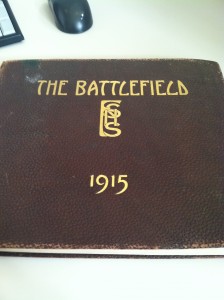
After agonizing weeks of waiting, we finally made it to the Central Rappahannock Heritage Center! All four of us made it, and we found some excellent resources–as we had hoped we would. We looked through many items, some of them useful, and some of them not. We started with Battlefield yearbooks, because they were the easiest items for the volunteers to pull. The CRHC has a very strict policy about copies and photos, but luckily the Battlefield yearbooks are digitized and available on the Internet Archive. The yearbooks had cool tidbits of information here and there that we can hopefully incorporate into the project about the homefront experience, and the ones before US entry into the war give us a good picture of how SNS was relatively unaffected by the war until 1917. I got to look through the 1915 Battlefield yearbook, and the Alumnae Pages had an interesting (and amusing) quote from an SNS graduate, Kathleen White: “She is much excited over the European War, and being a patriotic Canadian, she expresses a desire to enlist if worst comes to worst.”
Candice got to look at some postcards, and one of them is amazing! It depicts soldiers lying on the ground, holding their weapons and says “On The Firing Line.” It is from a man named Emmett to his Grandma. He writes: “Dear Grandma. Am at Fort Oglethorpe, Ga. Saw Dr. Pratt today. I don’t know where I’ll go from here. Love to all. Emmett.”
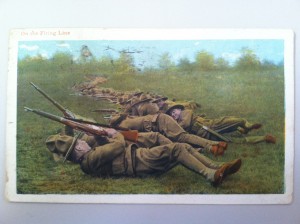
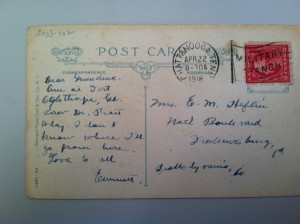
Candice also went through a collection of items from the Knox family and put together an awesome Google doc for us with lots of information about them! It contained personal letters, newspaper articles, a family history, photographs, recipes, and more. Another item that we were looking forward to getting our hands on was the homefront diary of Mary Eastburn–Jack got to look at these diaries and they are absolutely amazing! They are an excellent source of information about the homefront, like prices for goods and material shortages. We definitely want to construct a homefront timeline, and these diaries will most likely form the crux of it. Jack has already set to work entering the information into the Timeline tool that we learned about earlier this week. I’m so excited to see how everything turns out in the end! We would like to get digital images of the diary, but unfortunately that will have to wait for a little while, due to the CRHC’s policies and the expense of actually getting the digital images ($2.00 per image). Candice and I looked through several letters from the Stearns sisters, but they didn’t seem to be relevant to WWI. They made no mention of the war, but it is possible that other letters in the collection do–the collection is quite large and has not been cataloged yet. However, unless we end up with ample amounts of time to go through this collection, it doesn’t seem like the letters will be useful to us.
The last item I looked at before I left the CRHC was a book of minutes from the Mary Washington Hospital Association. It ran from 1913 to 1919, so I actually started at the back of the book first, thinking that I would come across mentions of the war sooner from that direction. The January 21, 1919 entry mentioned Liberty Bonds that the association purchased, and several entries from 1918 mention the “question of coal,” which may have been related to war shortages. Interestingly enough, the books of minutes skips almost an entire year–it goes from October 6, 1918 to October 15, 1919. This jump in time startled me, especially because the fall of 1918 was when the influenza epidemic hit Fredericksburg in full force, so I was expecting to find some entries making mention of the virus. It is a very conspicuous absence of information, and Jack and I are wondering if the association kept a separate book of minutes during the time period that is missing. We shall see! We didn’t finish looking through the book, so when we return to the CRHC I would like to skim over the rest of it.
I’m very pleased with our progress and really looking forward to seeing what more we can find!
Interesting Finds in the Archives:
“The time has come” the Walrus said, “to talk of many things.” (1915 Battlefield Yearbook)
A woman at the Mary Washington Hospital caused a large controversy when she gave birth to a child and then put it into the hospital’s furnace, unbeknownst to hospital staff.




